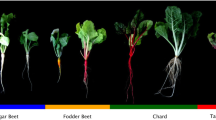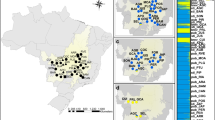Abstract
Key message
The genetic variation of Beta section Beta is structured into four taxonomic and spatial clusters. There are significant associations between molecular markers and environmental variables.
Abstract
We investigated the genetic diversity of Beta section Beta, which includes the wild and cultivated relatives of the sugar beet. The taxa included in the study were: Beta vulgaris subsp. maritima, B. vulgaris subsp. adanensis, B. macrocarpa, B. patula and B. vulgaris subsp. vulgaris (garden beet, leaf beet and swiss chards). We collected 1264 accessions originating from the entire distribution area of these taxa and genotyped them for 4436 DArT markers (DArTs). We showed that the genetic variation of these accessions is structured into four taxonomic and spatial clusters: (1) samples of Beta macrocarpa, (2) samples of Beta vulgaris subsp. adanensis, (3) Mediterranean and Asian samples and (4) Atlantic and Northern European samples. These last two clusters were mainly composed of samples of Beta vulgaris subsp. maritima. We investigated in deeper detail the genetic structure of B. vulgaris subsp. maritima, which constituted the majority (80 %) of the wild samples. This subspecies exhibited a clinal genetic variation from South-East to North-West. We detected some markers significantly associated to environmental variables in B. vulgaris subsp. maritima. These associations are interpreted as results of natural selection. The variable most often involved in the associations was annual mean temperature. Therefore, these markers can be useful for the development of frost-tolerant winter beets and drought-tolerant rain-fed beets.





Similar content being viewed by others
References
Andrello M, Jacobi MN, Manel S et al (2015) Extending networks of protected areas to optimize connectivity and population growth rate. Ecography 38:273–282. doi:10.1111/ecog.00975
Arnaud J-F, Viard F, Delescluse M, Cuguen J (2003) Evidence for gene flow via seed dispersal from crop to wild relatives in Beta vulgaris (Chenopodiaceae): consequences for the release of genetically modified crop species with weedy lineages. Proc R Soc Lond B Biol Sci 270:1565–1571
Arnaud J-F, Fénart S, Godé C et al (2009) Fine-scale geographical structure of genetic diversity in inland wild beet populations. Mol Ecol 18:3201–3215. doi:10.1111/j.1365-294X.2009.04279.x
Bartsch D, Lehnen M, Clegg J et al (1999) Impact of gene flow from cultivated beet on genetic diversity of wild sea beet populations. Mol Ecol 8:1733–1741
Berline L, Rammou A-M, Doglioli A et al (2014) A connectivity-based eco-regionalization method of the Mediterranean Sea. PLoS One 9:e111978. doi:10.1371/journal.pone.0111978
Biancardi E, Panella LW, Lewellen RT (2012) Beta maritima. The Origin of Beets. Springer
Bonin A, Ehrich D, Manel S (2007) Statistical analysis of amplified fragment length polymorphism data: a toolbox for molecular ecologists and evolutionists. Mol Ecol 16:3737–3758. doi:10.1111/j.1365-294X.2007.03435.x
Buttler KP (1977) Variation in Wild Populations of Annual Beet (Beta, Chenopodiaceae). Plant Syst Evol 128:123–136
Dale MFB, Ford-Lloyd BV (1985) The significance of multigerm seedballs in the genus Beta. Watsonia 15:265–267
De Cauwer I, Dufay M, Cuguen J, Arnaud J-F (2010) Effects of fine-scale genetic structure on male mating success in gynodioecious Beta vulgaris ssp. maritima. Mol Ecol 19:1540–1558. doi:10.1111/j.1365-294X.2010.04586.x
Desplanque B, Boudry P, Broomberg K et al (1999) Genetic diversity and gene flow between wild, cultivated and weedy forms of Beta vulgaris L. (Chenopodiaceae), assessed by RFLP and microsatellite markers. Theor Appl Genet 98:1194–1201
Ecke W, Michaelis G (1990) Comparison of chloroplast and mitochondrial DNA from five morphologically distinct Beta vulgaris cultivars: sugar beet, fodder beet, beet root, foliage beet, and Swiss chard. TAG Theor Appl Genet Theor Angew Genet 79:440–442. doi:10.1007/BF00226149
Evanno G, Regnaut S, Goudet J (2005) Detecting the number of clusters of individuals using the software structure: a simulation study. Mol Ecol 14:2611–2620. doi:10.1111/j.1365-294X.2005.02553.x
Falush D, Stephens M, Pritchard JK (2007) Inference of population structure using multilocus genotype data: dominant markers and null alleles. Mol Ecol Notes 7:574–578. doi:10.1111/j.1471-8286.2007.01758.x
Fénart S, Arnaud J-F, De Cauwer I, Cuguen J (2008) Nuclear and cytoplasmic genetic diversity in weed beet and sugar beet accessions compared to wild relatives: new insights into the genetic relationships within the Beta vulgaris complex species. Theor Appl Genet 116:1063–1077. doi:10.1007/s00122-008-0735-1
Fievet V, Touzet P, Arnaud J-F, Cuguen J (2007) Spatial analysis of nuclear and cytoplasmic DNA diversity in wild sea beet (Beta vulgaris ssp. maritima) populations: do marine currents shape the genetic structure? Mol Ecol 16:1847–1864. doi:10.1111/j.1365-294X.2006.03208.x
Frese L (2010) Conservation and Access to Sugarbeet Germplasm. Sugar Tech 12:207–219. doi:10.1007/s12355-010-0054-0
Frichot E, Francois O (2015) LEA: an R package for landscape and ecological association studies. Methods Ecol Evol 6:925–929. doi: 10.1111/2041-210X.12382
Frichot E, Schoville SD, Bouchard G, Francois O (2013) Testing for associations between loci and environmental gradients using latent factor mixed models. Mol Biol Evol 30:1687–1699. doi:10.1093/molbev/mst063
Guillot G, Vitalis R, le Rouzic A, Gautier M (2014) Detecting correlation between allele frequencies and environmental variables as a signature of selection. A fast computational approach for genome-wide studies. Spat Stat 8:145–155. doi:10.1016/j.spasta.2013.08.001
Henry RJ (2014) Sequencing of wild crop relatives to support the conservation and utilization of plant genetic resources. Plant Genet Resour-Charact Util 12:S9–S11
Hijmans RJ, Cameron SE, Parra JL et al (2005) Very high resolution interpolated climate surfaces for global land areas. Int J Climatol 25:1965–1978. doi:10.1002/joc.1276
Hjerdin A, Sall T, Nilsson NO et al (1994) Genetic variation among wild and cultivated beets of the section Beta as revealed by RFLP analysis. J Sugar Beet Res 31:59–67
Jakobsson M, Rosenberg NA (2007) CLUMPP: a cluster matching and permutation program for dealing with label switching and multimodality in analysis of population structure. Bioinformatics 23:1801–1806. doi:10.1093/bioinformatics/btm233
Jombart T, Ahmed I (2011) adegenet 1.3-1: new tools for the analysis of genome-wide SNP data. Bioinformatics btr521. doi: 10.1093/bioinformatics/btr521
Jombart T, Devillard S, Dufour AB, Pontier D (2008) Revealing cryptic spatial patterns in genetic variability by a new multivariate method. Heredity 101:92–103
Jombart T, Devillard S, Balloux F (2010) Discriminant analysis of principal components: a new method for the analysis of genetically structured populations. BMC Genet 11:94
Jones PD, Lister DH, Jaggard KW, Pidgeon JD (2003) Future climate impact on the productivity of sugar beet (Beta vulgaris L.) in Europe. Clim Change 58:93–108
Jung C, Pillen K, Frese L et al (1993) Phylogenetic relationships between cultivated and wild species of the genus Beta revealed by DNA “fingerprinting”. Theor Appl Genet 86:449–457. doi:10.1007/BF00838560
Kadereit G, Hohmann S, Kadereit JW (2006) A synopsis of Chenopodiaceae subfam. Betoideae and notes on the taxonomy of Beta. Willdenowia 36:9–19. doi:10.3372/wi.36.36101
Kilian A, Wenzl P, Huttner E et al (2012) Diversity arrays technology: a generic genome profiling technology on open platforms. In: Pompanon F, Bonin A (eds) Data production and analysis in population genomics. Humana Press, New York, pp 67–91
Kirchhoff M, Svirshchevskaya A, Hoffmann C et al (2012) High degree of genetic variation of winter hardiness in a panel of L. Crop Sci 52:179. doi:10.2135/cropsci2011.04.0185
Kornienko AV, Podvigina OA, Zhuzhzhalova TP et al (2014) High-priority research directions in genetics and the breeding of the sugar beet (Beta vulgaris L.) in the 21st century. Russ J Genet 50:1137–1148. doi:10.1134/S1022795414110064
Kraft T, Säll T, Fridlund B et al (1997) Estimating genetic variation in sugar beets and wild beets using pools of individuals. Genome 40:527–533
Letschert JPW (1993) Beta section Beta: biogeographical patterns of variation, and taxonomy. Wagening Agric Univ Pap 93(1):1–155
Leys M, Petit EJ, El-Bahloul Y et al (2014) Spatial genetic structure in Beta vulgaris subsp. maritima and Beta macrocarpa reveals the effect of contrasting mating system, influence of marine currents, and footprints of postglacial recolonization routes. Ecol Evol 4:1828–1852. doi:10.1002/ece3.1061
Maxted N, Ford-Lloyd BV, Jury S et al (2006) Towards a definition of a crop wild relative. Biodivers Conserv 15:2673–2685. doi:10.1007/s10531-005-5409-6
Monteiro F, Romeiras MM, Batista D, Duarte MC (2013) Biodiversity assessment of sugar beet species and its wild relatives: linking ecological data with new genetic approaches. Am J Plant Sci 04:21–34. doi:10.4236/ajps.2013.48A003
Ober ES, Clark CJA, Bloa ML et al (2004) Assessing the genetic resources to improve drought tolerance in sugar beet: agronomic traits of diverse genotypes under droughted and irrigated conditions. Field Crops Res 90:213–234. doi:10.1016/j.fcr.2004.03.004
Panella L, Lewellen RT (2007) Broadening the genetic base of sugar beet: introgression from wild relatives. Euphytica 154:383–400. doi:10.1007/s10681-006-9209-1
Pritchard JK, Stephens M, Donnelly P (2000) Inference of population structure using multilocus genotype data. Genetics 155:945–959
R Development Core Team (2014) R: a language and environment for statistical computing. R Foundation for Statistical Computing, Vienna
Rossi V, Ser-Giacomi E, López C, Hernández-García E (2014) Hydrodynamic provinces and oceanic connectivity from a transport network help designing marine reserves. Geophys Res Lett 41:2883–2891. doi:10.1002/2014GL059540
Ross-Ibarra J, Morrell PL, Gaut BS (2007) Plant domestication, a unique opportunity to identify the genetic basis of adaptation. Proc Natl Acad Sci USA 104:8641–8648. doi:10.1073/pnas.0700643104
Schoville SD, Bonin A, François O et al (2012) Adaptive Genetic Variation on the Landscape: methods and Cases. Annu Rev Ecol Evol Syst 43:23–43. doi:10.1146/annurev-ecolsys-110411-160248
Shen Y, Newbury HJ, Ford-Lloyd BV (1996) The taxonomic characterisation of annual Beta germplasm in a genetic resources collection using RAPD markers. Euphytica 91:205–212. doi:10.1007/BF00021071
Shen Y, Ford-Lloyd BV, Newbury J (1998) Genetic relationships within the genus Beta determined using both PCR-based marker and DNA sequencing techniques. Heredity 80:624–632
USDA/ARS Germplasm Resources Information Network–(GRIN) National Germplasm Resources Laboratory, Beltsville MD. http://www.ars-grin.gov. Accessed 20 Apr 2015
van Geyt JPC, Lange W, Oleo M, De Bock TSM (1990) Natural variation within the genus Beta and its possible use for breeding sugar beet: a review. Euphytica 49:57–76
Villain S (2007) Histoire évolutive de la section Beta: mise en évidence des phénomènes d’hybridation et de spéciation au sein de la Section dans le bassin Méditerranéen. Ph.D., Université Lille 1-Sciences et Technologies
Warschefsky E, Penmetsa RV, Cook DR, von Wettberg EJB (2014) Back to the wilds: tapping evolutionary adaptations for resilient crops through systematic hybridization with crop wild relatives. Am J Bot 101:1791–1800. doi:10.3732/ajb.1400116
Yoshida Y, Matsunaga M, Cheng D et al (2012) Mitochondrial minisatellite polymorphisms in fodder and sugar beets reveal genetic bottlenecks associated with domestication. Biol Plant 56:369–372. doi:10.1007/s10535-012-0101-7
Author information
Authors and Affiliations
Corresponding author
Ethics declarations
Conflict of interest
The authors declare no conflict of interest.
Additional information
Communicated by A. H. Schulman.
Electronic supplementary material
Below is the link to the electronic supplementary material.
Rights and permissions
About this article
Cite this article
Andrello, M., Henry, K., Devaux, P. et al. Taxonomic, spatial and adaptive genetic variation of Beta section Beta . Theor Appl Genet 129, 257–271 (2016). https://doi.org/10.1007/s00122-015-2625-7
Received:
Accepted:
Published:
Issue Date:
DOI: https://doi.org/10.1007/s00122-015-2625-7




